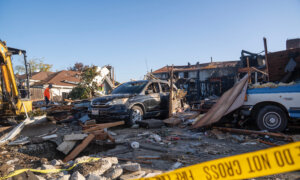A U.S. Navy warship that fell into enemy hands during World War II, got a Japanese makeover, and became known as the “Ghost Ship of the Pacific” has been discovered off Northern California.
Locating the wreck of the USS Stewart was a collaborative effort to test the robotic marine survey technology of the Ocean Infinity company of Austin, Texas.
“It’s an opportunity, with each find or rediscovery, to go back and pick up that book, if you will, to read that story again or to introduce that story to a new generation,” said James Delgado, senior vice president of SEARCH Inc., which participated in the expedition.

Image of the USS Stewart's stern. (Ocean Infinity)
The Stewart was commissioned in September 1920 and stationed in Manila, Philippines, in 1941 as part of the U.S. Navy’s Asiatic Fleet after Imperial Japan’s attack on Pearl Harbor.
In February 1942, it was damaged during combat. An accident caused the ship to be trapped in a repair dry dock at Surabaya, Netherlands East Indies, and the crew had to abandon it as the Japanese prepared to take over the island.
A lieutenant commander in the Imperial Japanese Navy named Shizuo Fukui acquired the vessel, repaired it, and, a year later, used it in the Imperial Japanese Navy as Patrol Boat No. 102. The Stewart had many Japanese elements installed during its repairs.
“[They] refitted the vessel as a Japanese patrol boat, removed its torpedo launching tubes, kept its depth charge racks, replaced all the guns and the radar with Japanese equipment ... changed the forward stacks of the funnels ... made it look more Japanese, added a Japanese style mast,” Delgado said.
There were also Japanese instructions next to English labels explaining how to operate the equipment.
Toward the end of the war, pilots and allies spotted the Stewart a few times as they pushed farther into the Pacific against the Japanese.
“Initial reports were, ‘Hey, it looks like one of our ships. No, it looks sort of Japanese, and it’s like it’s the old Stewart.’ So that’s how it became known as the ‘Ghost Ship of the Pacific,’ the ship basically came back from the dead,” Delgado said.
At the end of the war, the U.S. Navy found the Stewart afloat in Kure, Japan. It was returned to the U.S. Navy in what many described as an “emotional ceremony” and towed back to San Francisco for a brief display, treated like a prisoner of war. The sailors at the time referred to it as “RAMP-224,” an acronym for Recovered Allied Military Personnel and the vessel’s Navy hull number.

Officers salute as the U.S. national anthem is played during recommissioning ceremonies on the Stewart's foredeck while she was moored in Hiro Wan, Japan, on Oct. 29, 1945. Her new commanding officer, Lt. Cmdr. Harold H. Ellison, is standing by the microphone in the right-center foreground. (Official U.S. Navy photograph, now at the National Archives)

Arriving under tow in San Francisco Bay in early March 1946. (Photo courtesy of Donald M. McPherson, 1977/U.S. Naval History and Heritage Command photograph)

Being sunk as a target on May 24, 1946. The Stewart had already been bombed by aircraft and was under fire by the 40 mm single-gun mount in the foreground. (Official U.S. Navy photograph, now at the National Archives)
“It’s clear they thought of Stewart more like a shipmate than a ship,” said Russ Matthews, president of the nonprofit Air/Sea Heritage Foundation, which also participated in the expedition. “And I know I speak for the entire expedition team when I say that we’re all very satisfied to have helped honor the legacy and memory of those veterans once again.”
The battered ship was towed back out to sea to be given a “burial” but served the United States one last time. The Stewart was used as part of a naval exercise in which pilots practiced shooting at it with aerial rockets, machine guns, and naval guns for more than two hours before it officially went under on May 24, 1946.
“There was no need for the vessel anymore. It was worn out. It was rat-infested. It had still had damage that had been patched, and it was no longer even operable,” Delgado said. “The easy thing to do is to take her out to sea and say goodbye.”
About 78 years later, on Aug. 1, Ocean Infinity found the wreck by deploying three HUGIN 6000 autonomous underwater vehicles near Point Reyes National Seashore, about 36 miles northwest of San Francisco. Each unmanned submersible is equipped with sonar and multibeam echosounder systems, which can scan the seafloor. Together, they mapped 100 square miles of seabed.
Delgado said the wreckage was located within a few hours, 3,500 feet below the surface. Ocean scientists took notes and photos to document the artifact. It is mostly intact, and its hull was upright on the seafloor. Scientists say the ship is preserved exceptionally well.
“Those are the torpedo racks. There’s the superstructure, yes, OK, there’s now, that’s where a rocket hit during the sinking, you know, the sinking exercise and so on,” Delgado said.
The high-resolution sonar, photos, and videos collected from the site will be given to the Cordell Bank National Marine Sanctuary to help scientists better understand marine life and ecological changes.

High-resolution synthetic aperture sonar image of the USS Stewart. (Ocean Infinity)
The Stewart will remain where it is, underwater, protected under the Sunken Military Craft Act. Over the decades, it became a habitat for anemones, fish, and other marine life. Its bell and some other artifacts are already in museums.
“It’s too deep for anybody to really visit. And to what purpose would you want to go back?” Delgado said. “So this was just basically writing the last page in the history of the Stewart by saying that’s where she was sunk. Here she is, and this is what she looks like, and now she sits in the great museum of the sea.”
As an archaeologist, Delgado takes a longer view of history in reference for the future.
“A ship like this that spans two countries, two cultures, and all of the history that is represented in the story of Stewart, is a reminder that countries can be friends,” he said. “[Japan and the U.S. are] close friends and allies, and that ship speaks not only to the unfortunate part of the history, but stands in sharp contrast in terms of what happened to it with where we are today.”














